TURKMENISTAN SEPT 26 2015
- Brian Belmont

- May 25, 2020
- 15 min read
Updated: Jun 7, 2020
September 26, 2015

Having another rough night was tiring, in many ways. I awakened so many times, even though I got to sleep very easily, when I finally go up, 7:15am, I was wiped. I was so weak that making it to the bathroom to get ready,
I was packed and out by 7:45pm, down to the breakfast room and ready to go shortly after. I looked at the breakfast spread and felt queasy again.

We were ready for Eugenia when she arrived. She asked how I was doing and I asked for a quick stop for some yoghurt and bananas, she obliged and went with me to the market and negotiated the transaction. It made it easier. Tess stopped for a photo op with two local ladies. She is a force of nature. I could take a few tips from her.
Our first stop was Merv, a major oasis-city in Central Asia, on the historical Silk Road, located near today's Mary in Turkmenistan.
Several cities have existed on this site, which is significant for the interchange of culture and politics at a site of major strategic value. It is claimed that Merv was briefly the largest city in the world in the 12th century. It is a UNESCO World Heritage Site.
What an amazing history. Here’s how it stacks up -
Merv's origins are prehistoric: archaeological surveys have revealed many traces of village life as far back as the 3rd millennium BC and that the city was culturally part of the Bactria-Margiana Archaeological Complex. Under the name of Mouru, Merv is mentioned with Balkh in the geography of the Zend-Avesta (commentaries on the Avesta). Mouru was among the sixteen perfect lands created by Ahura Mazda.
Under the Achaemenid dynasty Merv is mentioned as being a place of some importance: under the name of Margu it occurs as part of one of the satrapies in the Behistun inscriptions (ca. 515 BC) of the Persian monarch Darius Hystaspis. The first city of Merv was founded in the 6th century BC as part of the expansion into the region by the Achaemenid Empire of Cyrus the Great (559–530 BC), but the Achaemenid levels are deeply covered by later strata at the site.
Alexander the Great's visit to Merv is merely legendary, but the city was named Alexandria] for a time. After Alexander's death, Merv became the capital of the Province of Margiana of the Seleucid, Bactrian, Parthian, and Sassanid states. Merv was renamed Antiochia Margiana by the Seleucid ruler Antiochus Soter, who rebuilt and expanded the city at the site presently known as Gyaur Gala (Turkish Gayur Kala) (Fortress). It was ruled in succession by Bactria, Parthia, and the Kushans after the fall of the Seleucid dynasty. It was a major city of Buddhism learning with Buddhist monastery temples for many centuries until its Islamicization. At the site of Gyaur Kala and Bairam Ali Buddhism was followed and practised often at the Buddhist stupa.
After the Sassanid Ardashir I (220–240 AD) took Merv, the study of numismatics picks up the thread: a long unbroken direct Sassanian rule of almost four centuries is documented from the unbroken series of coins originally minted at Merv. During this period Merv was home to practitioners of various religions beside the official Sassanid Zoroastrianism, including Buddhists, Manichaeans, and Christians of the Church of the East.
Between the 6th (553) and 11th centuries AD, Merv was the seat of an East Syrian metropolitan province. Sassanid rule was briefly interrupted by the Hephthalite occupation from the end of the 5th century to 565 a.d.
Abdullah Kahn Kala, which only the 15th century walls still exist - sort of. You can still make out some of the corner posts. The most still exists in some areas. If did in the area I visited. It looked like Chinggis Kahn had been through and left blood in the water after a siege but that was not he case. It was polluted.
Sassanian rule came to an end when the last Sassanian ruler, Yazdegerd III (632–651) was killed not far from the city and the Sassanian military governor surrendered to the approaching Arab army. The city was occupied by lieutenants of the caliph Umar, and became the capital of the Umayyad province of Khorasan. In 671, Ziyad ibn Abi Sufyan sent 50,000 Arab troops to Merv as a colony. This colony retained its native Kufan sympathies and became the nucleus of Khurasan. Using this city as their base, the Arabs, led by Qutayba ibn Muslim, brought under subjection large parts of Central Asia, including Balkh, Bokhara, and Fergana. Merv, and Khorasan in general was to become one of the first parts of the Persian-speaking world to become majority-Muslim. Arab immigration to the area was substantial. A Chinese captured at Talas, Du Huan, was brought to Baghdad and toured the caliphate. He observed that in Merv, Khurasan, Arabs and Persians lived in mixed concentrations.
Merv reached renewed importance in February 748 when the Iranian general Abu Muslim (d. 755) declared a new Abbasid dynasty at Merv, expanding and re-founding the city, and, in the name of the Abbasid line, used the city as a base of rebellion against the Umayyad caliphate. After the Abbasids were established in Baghdad Abu Muslim continued to rule Merv as a semi-independent prince until his eventual assassination. Indeed, Merv was the center of Abbasid partisanship for the duration of the Abbasid revolution, and later on became a consistent source of political support for the Abbasid rulers in Baghdad, and the governorship of Khurasan at Merv was considered one of the most important political figures of the Caliphate. The influential Barmakid family was based in Merv and played an important part in transferring Greek knowledge (established in Merv since the days of the Seleucids and Greco-Bactrians) into the Arab world.
Throughout the Abbasid era, Merv remained the capital and most important city of Khurasan. During this time, the Arab historian Al-Muqaddasi called Merv "delightful, fine, elegant, brilliant, extensive, and pleasant". Merv's architecture perhaps provided the inspiration for the Abbasid re-planning of Baghdad. The city was notable for being a home for immigrants from the Arab lands as well as from Sogdia and elsewhere in Central Asia (Herrmann 1999). Merv's importance to the Abbasids was highlighted in the period from 813 to 818 when the temporary residency of the caliph al-Ma'mun effectively made Merv the capital of the Muslim world. Merv was also the center of a major 8th-century Neo-Mazdakite movement led by al-Muqanna, the “Veiled Prophet”, who gained many followers by claiming to be an incarnation of God and heir to Abu Muslim; the Khurramiyya inspired by him persisted in Merv until the 12th century.
During this period Merv, like Samarkand and Bukhara, was one of the great cities of Muslim scholarship; the celebrated historian Yaqut studied in its libraries. Merv produced a number of scholars in various branches of knowledge, such as Islamic law, hadith, history, and literature. The city continued to have a substantial Christian community. In 1009 the Archbishop of Merv sent a letter to the Patriarch at Baghdad asking that the Keraits be allowed to fast less than other Nestorian Christians.
As the caliphate weakened, Arab rule in Merv was replaced by that of the Persian general Tahir Husayn and his Tahirid dynasty in 821. The Tahirids were in turn replaced in Merv by the first the Saffarids, then the Samanids and later the Ghaznavids.
In 1037, the Seljuks, a clan of Oghuz Turks moving from the steppes east of the Aral Sea, peacefully took over Merv under the leadership of Toghril Beg—the Ghaznavid sultan Masud was extremely unpopular in the city. Togrul's brother Çagry stayed in Merv as the Seljuk domains grew to include the rest of Khurasan and Iran, and it subsequently became a favorite city of the Seljuk leadership. Alp Arslan and his descendant Sultan Sanjar were both buried at Merv.
It is during this period that Merv expanded to its greatest size—Arab and Persian geographers termed it "the mother of the world", the "rendezvous of great and small", the "chief city of Khurasan" and the capital of the eastern Islamic world. Written sources also attest to a large library and madrasa founded by Nizam al-Mulk, as well as many other major cultural institutions. Perhaps most importantly, Merv was said to have a market that is "the best of the major cities of Iran and Khurasan" (Herrmann 1999). It is believed that Merv was the largest city in the world from 1145 to 1153, with a population of 200,000.
Sanjar's rule, marked by conflict with the Kara-Khitai and Khwarazmians, ended in 1153 when the Turkish Ghuzz nomads from beyond the Amu Darya pillaged the city. Subsequently Merv changed hands between the Khwarazmians of Khiva, the Ghuzz, and the Ghurids, and began to lose importance relative to Khurasan's other major city, Nishapur.
In 1221, Merv opened its gates to Tolui, son of Genghis Khan, chief of the Mongols, on which occasion most of the inhabitants are said to have been butchered. The Persian historian Juvayni, writing a generation after the destruction of Merv, wrote
"The Mongols ordered that, apart from four hundred artisans. .., the whole population, including the women and children, should be killed, and no one, whether woman or man, be spared. To each [Mongol soldier] was allotted the execution of three or four hundred Persians. So many had been killed by nightfall that the mountains became hillocks, and the plain was soaked with the blood of the mighty.”
Some historians believe that over one million people died in the aftermath of the city's capture, including hundreds of thousands of refugees from elsewhere, making it one of the most bloody captures of a city in world history.
Excavations revealed drastic rebuilding of the city's fortifications in the aftermath, but the prosperity of the city was over. The Mongol invasion was to spell the end for Merv and indeed other major centres for more than a century. After Moghol conquest, it was part of Ilkhanate and was consistently looted by Chagatai Khanate. In the early part of the 14th century, the town was made the seat of a Christian archbishopric of the Eastern Church and under the rule of the Kartids, vassals of the Ilkhanids. By 1380 Merv belonged to the empire of Timur (Tamerlane).
In 1505, the city was occupied by the Uzbeks, who five years later were expelled by Shah Ismail, the founder of the Safavid dynasty of Persia. It was in this period that a large dam (the 'Soltanbent') on the river Murghab was restored by a Persian nobleman, and the settlement which grew up in the area thus irrigated became known as 'Baýramaly', by which name it is referred to in some 19th-century texts. Merv remained in the hands of Persia except Uzbek rule between 1524 and 1528 and again between 1588 and 1598 until 1785, when it was captured by Shah Murad the Emir of Bokhara. Few years later in 1788 and 1789, the Bukharan Shah Murad Beg, razed the city to the ground, broke down the dams, and converted the district into a waste. The entire population of the city and the surrounding oasis of about 100,000 were then deported in several stages to the Bukharan oasis and the Zarafshan Valley. Being nearly all Persian-speaking Shi'as, the deportees resisted assimilation into the Sunni population of Bukhara, despite the common language they spoke with most Bukharan natives. These Marvis survive today—and were listed as "Iranis/Iranians" in Soviet censuses through the 1980s. They are found now in Samarkand as well as Bukhara and the area in between on the Zarafshan river.
Merv was passed to Khanate of Khiva in 1823. Sir Alexander Burnes traversed the country in 1832. About this time, the Tekke Turkomans, then living on the Tejen River, were forced by the Persians to migrate northward. Khiva contested the advance of the Tekkes, but ultimately, about 1856, the latter became the sovereign power in the country, and remained so until the Russians occupied the oasis in 1884. By 1868 the Russians had taken most of Russian Central Asia except Turkmenistan. They approached this area from the Caspian and in 1881 captured Geok Tepe. Merv was taken bloodlessly by a man named Alikhanov. He was a Muslim from the Caucasus who had risen to the rank of Major in the Russian service. After fighting a duel with a superior officer he was demoted to the ranks and by 1882 had risen to lieutenant. In 1882 he entered Merv claiming to be a Russian merchant and negotiated a trade agreement. Meanwhile, Russian agents had used a mixture of bribes and threats to develop a pro-Russian party in the area. The Russians occupied the oasis of Tejen eighty miles to the west. In 1884 Alikhanov entered Merv in the uniform of a Russian officer along with a number of Turkoman notables who had already submitted. He claimed that the troops at Tejen were the spearhead of a larger force and that local autonomy would be respected. Seeing no hope of support from Persia or Britain, the elders submitted. The next Russian move was south toward Herat.
Some exploratory excavations at Merv were conducted in 1885[15] by the Russian general A.V. Komarov, the governor of the Transcaspian oblast, 1883–89; Komarov employed his Tsarist troops as excavators and published his collection of trophy artifacts and coins from the area in 1900.The first fully professional dig was directed by Valentin Alekseevich Zhukovsky of the Imperial Archaeological Commission, in 1890 and published in 1894. The American Carnegie Institute's excavations were under the direction of a geologist, Raphael Pumpelly, and a German archaeologist, Hubert Schmidt.
Merv is currently the focus of the Ancient Merv Project (initially as the International Merv Project). From 1992 to 2000, a joint team of archaeologists from Turkmenistan and the UK have made remarkable discoveries. In 2001, a new collaboration was started between the Institute of Archaeology, University College London and the Turkmen authorities.
This Ancient Merv Project is concerned with the complex conservation and management issues posed by this remarkable site, furthering our understanding of the site through archaeological research, and disseminating the results of the work to the widest possible audience.

On the way to the first site, we could see a camel roaming in a field and in the distance, more of Ancient Merv.
Next up was the Greater and lesser Kyz Kala. The greater is the more dramatic as you'd expect, Looking a bit Greek but made of mud brick instead of stone, you must use some imagination but can easily see that this was a place of significance. You are still able to make out some room details, that's more than some sites have to offer.
Some ladies and a little girl walked by while we were walking between the Greater and Lessser Kallas and with Tess's way of connecting with people, we were soon taking pics with them. They were at a well, an ancient one, where they were getting water.
There's little I'd the Lesser to be seen but it is worth the visit as you'll be at the Greater Kalla. The lesser has access that the Greater doesn't so you are able to get close up to the details that are left,. As mentioned earlier, they were constructed by the Sassanians in the 7th century and still used as function rooms 600 years later.
There are some details left after all of the destruction and erosion. I found an nfinity symbol - Rams horns - other small details.
The Mauseloem's of two Askhabs (standard bearers) of the prophet Mohamad. The two buildings sit in front of two Timurid Aivans reconstructed in the 15ty century.. They are under renovation at the moment.
Erk Gala (from Persian, "the citadel fort") is the oldest part of the city of Merv complex. Built in the 7th century BC Erk Gala was built as a Persian Style fortress controlling the oasis on the Murghab River. The Erk Gala fortress later served as the acropolis for the Hellenistic city and later the Arc of the Islamic city. There was also a Buddhist Stupa on the site
After visiting the major sites, we stopped at new mosque and school. The rest went to see a communal kitchen. I rested as I couldn't take the smell of food. There some young guys who came and stood by me and then paced. Then came back and stood there beside me, paced some more and then finally walked away. It was a bit strange but…I wasn’t bothered or worried
Mausoleum of Sultan Sanjar -38 meters high - visible across the steppe from 30 km away.
The best remaining testimony to Seljuq power at Merv is the 38m-high Mausoleum of Sultan Sanjar, located in what was the centre of Sultan Kala. The building was restored with Turkish aid and rises dramatically in the open plain.
Sanjar, grandson of Alp-Arslan, died in 1157, reputedly of a broken heart when, after escaping from captivity in Khiva, he came home to find that his beloved Merv had been pillaged by Turkic nomads.
The mausoleum is a simple cube with a barrel-mounted dome on top. Originally it had a magnificent turquoise-tiled outer dome, said to be visible from a day’s ride away, but that is long gone. Interior decoration is sparse, though restoration has brought back the blue-and-red frieze in the upper gallery. Inside is Sanjar’s simple stone ‘tomb’ although, fearing grave robbers, he was actually buried elsewhere in an unknown location. The name of the architect, Mohammed Ibn Aziz of Serakhs, is etched into the upper part of the east wall. According to lore, the sultan had his architect executed to prevent him from designing a building to rival this one.
The structure is covered in very expressive interior details, not common in Muslim design. It was an amazing architectural gem.
Off to the side is a curved step that locals bring knotted fabric to lay on the step - white for a boy and any color for a girl.
Nearby there is a tree - a place with knots of fabric to promote fertility - boys (white fabric) nd girls (any other color) - The tree and surrounding low trees/shrubs created a unique desert landscape.
Continuing on, we passed guys picking cotton in the fields. This reminded me that I had overheard the hotel clerks talking about his friend who was friend doing that to help pay the bills.
Back in Mary, Jose, Eugenia, and I went to eat while the rest went to the bazaar. I wanted to go to the bazaar but I needed to try to eat something.
I had something different - mashed lentil soup. So so. The restaurant was virtually empty but it was the middle of the day. We needed to go and meet up with the rest to visit the Museum.
We were 5 minutes late being ready so they left without us, so we took a shared taxi to the museum to catch up.
Mary regional museum...great information by guide. No pics...but a few of the yurt. Great art collection.
The museum is the highlight in Mary. This excellent museum housed in a sparkling white-marble palace across the river from the centre of town. The enormous premises is home to a collection of taxidermy, temporary exhibits and a gallery of Turkmen art, but the real reason to visit is the superb archaeological collection on the upper floor, full of discoveries from Margush (Gonur) and Merv, as well as impressively detailed models of both sites. Other highlights include a late third millennium BC tabernacle from Gonur, and lots of impressively preserved porcelain, coins, weapons, jewellery and amphorae. There’s also an extensive ethnography section, including a large collection of Turkmen jewellery, carpets, stuffed animals, a fully decorated yurt and pottery from the time of the Mongol occupation
Eugenia had the souvenir shop open. I really didn't see anything of value...and then some art caught my eye. One really looked quite similar some art that I admired in the museum. I asked the price. The lady said that she had painted it. She asked 85 manat. She got busy with the rest of my group, then came back to me. I had 3 - 20 manat bills in my hand. I told her that it was all that I had left and put the bills near her hand. She accepted and even signed the front for me. She also let Michael take a pic of the two of us and her painting, Whoohoo!
Now, off to the airport and Ashgabat.
Upon entering Mary's airport, your bags are screened (very common in Middle Eastern countries). Once though, we waited in a line to get your ticket/passport checked. Then the check in lady who assigns your seat. Good luck with reading the number. Another security screening of the bags, and I'd made it through. There seemed to be no consistency with their policies. As they were much harder on my than Jose.
When boarding the flight, I had the longest walk on a runway ever. I wood guess it to be 1/4 mile or more. Maybe it was required as it forces us to view the large portrait of the president before entering the plane.
Michael sat next to me on the flight and it was uneventful, we worked on pics and I blogged a bit.
No customs or immigration on arrival...how nice. Elena handle on her luggage was broken but that was the noisy casualty. Michael went to find our guide and I waited did his luggage. Two problems arose. I had Michaels luggage and I didn't have his claim check. It was required to leave the area, Michael had left the building and now wasn't being allowed back in, I asked Yanko to get Michaela ticket and hand it off to me but somehow Michael made it back in the building, ducking under security lanes. He handed it off to me so I could leave the holding area.
He had been told that his bag being left more than 3 feet away constituted abandonment, anyway...alls well...right!
We snaked through the grotesquely repetitious and bland grand buildings all covered in white marble...all the same marble.
There was the last night of they 3 day holiday for everyone and the streets were busy, taking some time to get through the clogged streets to the hotel
Once we reached it, here was a massive / loud party across the street. Hmmm?

Checking in was little muss and fuss in comparison to Tashkent but the girls seemed to be simple. Now...we already knew about Turkmenistan's paranoia with social media. Now...a new level...not omit can you not connect to any social media but your password to use what Internet that you can access is specifically tied to your device...so they can track you and what you're doing. I don't like this county.
Reaching the room, I realized that party central was going to leave me sleepless. I went to reception and questioned about it. They promised that the must would lessen at 10:40 and stop at 11pm. I told them I would hold them to that.
I couldn’t eat, again. Everything kept coming up, again. I was getting weaker but kept pushing on.
In the morning, I would have a discussion with the group and reception about the potential evenings activities. If there was going to be sorry again...something had to change.
Nighty night

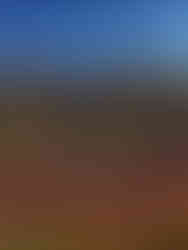
















































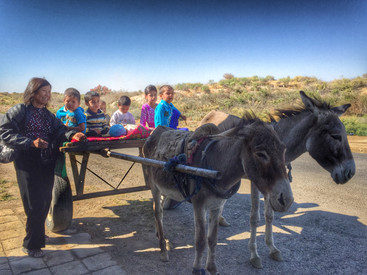


































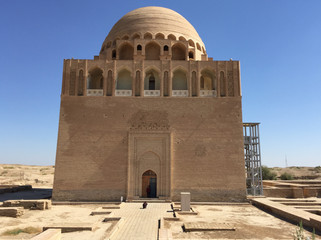





























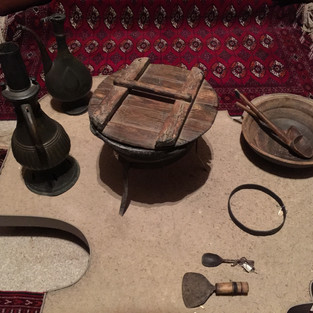












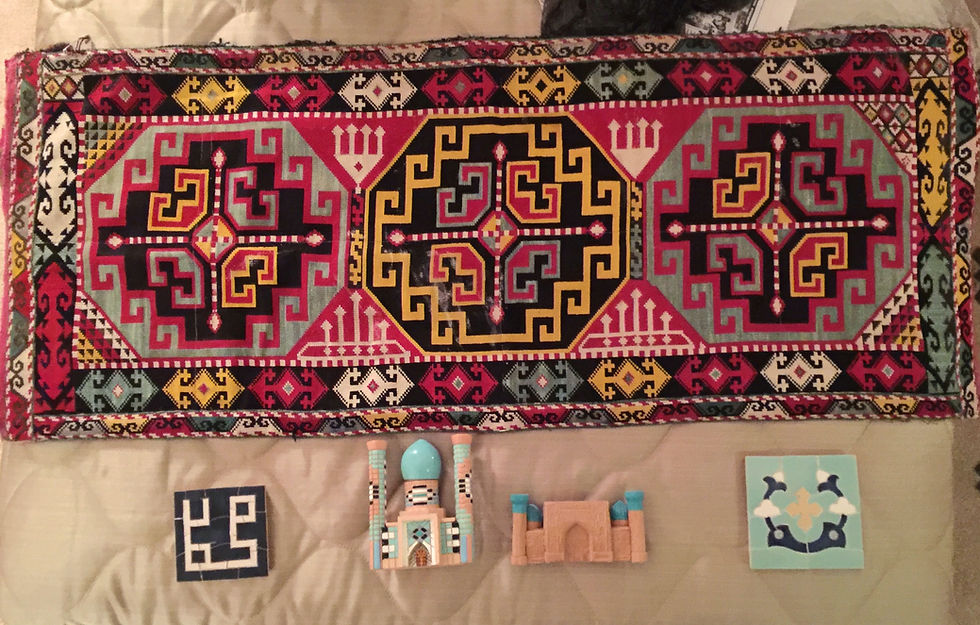


Comments